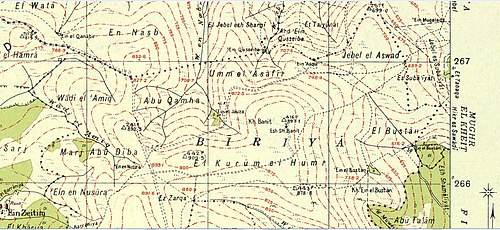| Jamnith | |
|---|---|
| Jabnith; Jamnia; Kh. Banit | |
 Photo of Safed taken in 1948 from atop Mount Canaan (near Kh. Banit) | |
| Nearest city | Safed |
| Coordinates | 32°59′29″N 35°31′01″E / 32.99139°N 35.51694°E |
| Established | Hellenistic period (?) |
Jamnith (Greek: Ἰαμνειθ), also Jabnith, Yavnit (Hebrew: יבנית), Iamnia, or in medieval parlance, Ibnit / Abnit / Ovnit, is a ruin in the Upper Galilee that came to renown during the First Jewish Revolt in the 1st-century CE. The ruin, known locally by the name Khurbet esh-Sheikh Banit, or simply Kh. Banît, lies about 3.4 kilometres (2.1 mi) to the northeast of Safed, in the Biriya Forest, and was once a fortified town towards the northeast of Mount Canaan (Hebrew: Har Kena'an), upon a hill called Har Yavnit.[1] The hill on which the village ruins lie rises 836 metres (2,743 ft) above sea level and overlooks the Hula valley. Access to the ruin is now restricted because of an enclosed military installation built over the site.
The village is mentioned twice in the writings of Josephus as being in the Upper Galilee; once in The Jewish War (2.20.6) under the appellation Ἰαμνειθ, and again in Vita §37 under the name Ίαμνια, and is distinguished from the Jamnia of Judaea. Josephus testifies of himself that he assisted in building the wall of the village,[2] the reference perhaps being to funding its building project. The hilltop fortress has no natural spring, suggesting that its inhabitants relied upon rock-cut cisterns for water, of which several can be found on the site.
The fate of the town's defenders is not known, but they are presumed to have surrendered after the fall of Tarichaea.[3]
Victor Guérin visited the site in the late 19th-century and found on the plateau of the elevated hill, which he called Kharbet Benit, what he described as "a village, now overthrown from top to bottom, and of which there are only many piles of stones from demolished houses."[4] Earlier, in 1838, the site was visited by Edward Robinson, who wrote, "here (Benit) are the slight remains of a former village, situated directly on the brow of the mountains enclosing the Huleh, and commanding a splendid view over the whole basin and the surrounding region."[5]
Michael Avi-Yonah thought that the priestly course known as Bilgah had its place of residence in Yavnit.[6]

- ^ Vilnai, Ze'ev (1978). Ariel: Encyclopedia le-Yedi'at Ha-Aretz (in Hebrew). Vol. 8–10. Tel-Aviv: 'Am 'Oved. p. 2690. OCLC 14912218.
- ^ Josephus, The Jewish War 2.20.6 (2.572, 576); idem, Vita 188 (s. 37)
- ^ Josephus, The Jewish War, iv.1. "After the fall of Jotapata some of the Galilaeans had remained in revolt against Rome; but when Tarichaea was overthrown they surrendered, and the Romans took over all the fortresses and towns except Gischala and the garrison of Mt Tabor."
- ^ Guérin 1880, p. 439.
- ^ Robinson, E.; Smith, E. (1856), p. 434; cf. pp. 439, 449-450, 575
- ^ Avi-Yonah, Michael (1964). "The Caesarea Inscription of the Twenty-Four Priestly Courses". Eretz-Israel: Archaeological, Historical and Geographical Studies (in Hebrew). L.A. Mayer Memorial Volume (1895–1959): 25. JSTOR 23614642.; on this priestly ward, see Mishnah Sukkah 5:8, Tosefta Sukkah 4:28, and 1 Chronicles 24:14